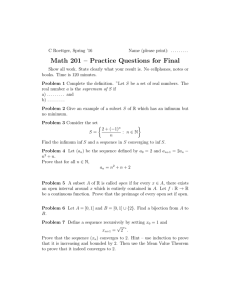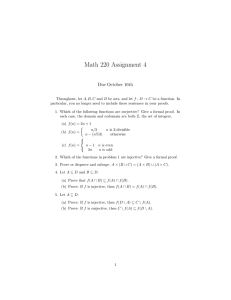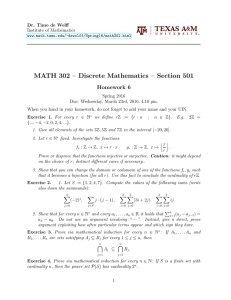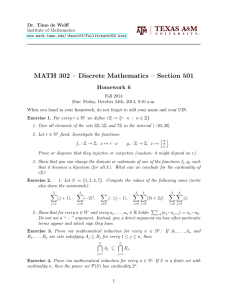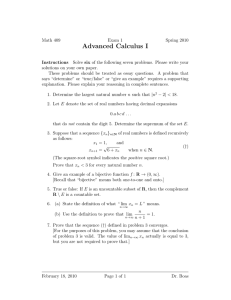Math 201 – Practice Questions for Final – solutions
advertisement
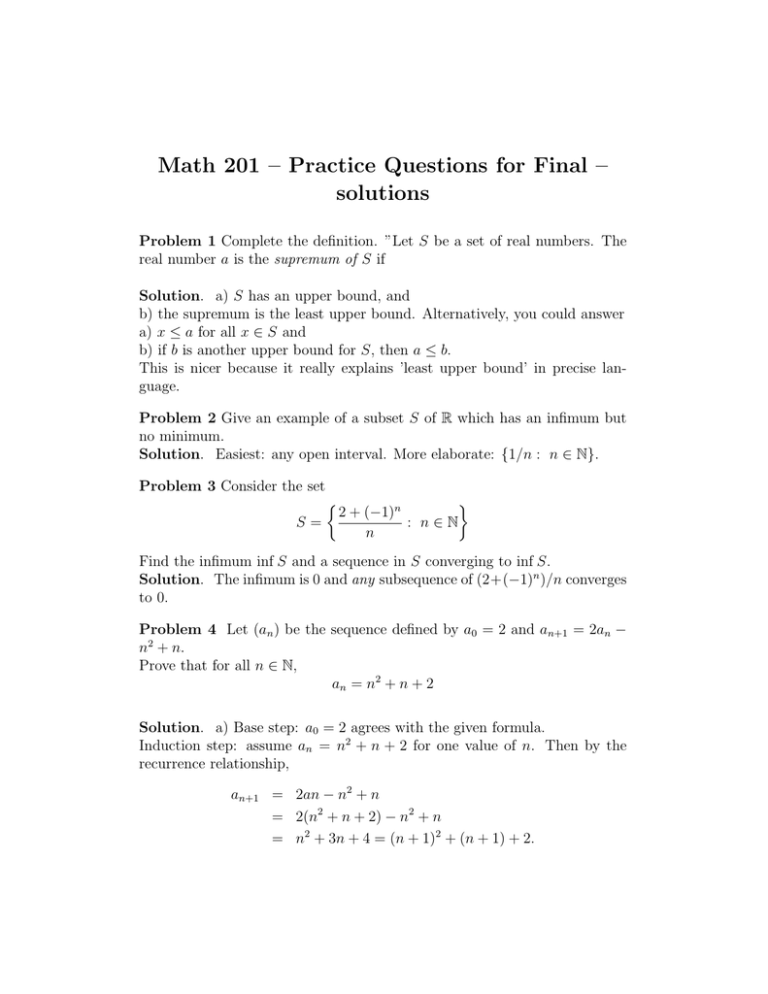
Math 201 – Practice Questions for Final –
solutions
Problem 1 Complete the definition. ”Let S be a set of real numbers. The
real number a is the supremum of S if
Solution. a) S has an upper bound, and
b) the supremum is the least upper bound. Alternatively, you could answer
a) x ≤ a for all x ∈ S and
b) if b is another upper bound for S, then a ≤ b.
This is nicer because it really explains ’least upper bound’ in precise language.
Problem 2 Give an example of a subset S of R which has an infimum but
no minimum.
Solution. Easiest: any open interval. More elaborate: {1/n : n ∈ N}.
Problem 3 Consider the set
S=
2 + (−1)n
: n∈N
n
Find the infimum inf S and a sequence in S converging to inf S.
Solution. The infimum is 0 and any subsequence of (2+(−1)n )/n converges
to 0.
Problem 4 Let (an ) be the sequence defined by a0 = 2 and an+1 = 2an −
n2 + n.
Prove that for all n ∈ N,
an = n 2 + n + 2
Solution. a) Base step: a0 = 2 agrees with the given formula.
Induction step: assume an = n2 + n + 2 for one value of n. Then by the
recurrence relationship,
an+1 = 2an − n2 + n
= 2(n2 + n + 2) − n2 + n
= n2 + 3n + 4 = (n + 1)2 + (n + 1) + 2.
Problem 5 A subset A of R is called open if for every x ∈ A, there exists
an open interval around x which is entirely contained in A. Let f : R → R
be a continuous function. Prove that the preimage of every open set is open.
Solution. Let A be an open subset of R. Let P be the preimage of A.
We want to prove that P is open. So let x0 ∈ P . Then y0 = f (x0 ) ∈ A by
definition of P . Since A is open, there exists ε > 0 such that
(y0 − ε, y0 + ε) ⊆ A.
Since f (x) is continuous, there exists δ > 0 such that for all x in (x0 −δ, x0 +δ)
|f (x) − f (x0 )| = |f (x) − y0 | < ε.
In other words,
f (x) ∈ (y0 − ε, y0 + ε).
The last interval is a subset of A, so f (x) ∈ A which proves x ∈ P . So P
contains the open interval (x0 − δ, x0 + δ). This completes the proof that P
is an open set.
Problem 6 Let A = [0, 1] and B = [0, 1] ∪ {2}. Find a bijection from A to
B.
Solution. Let (xn ) be any increasing sequence in A. One could choose eg
xn = 1 − 1/n, but many other choices are possible. Let S be the set of all xn
(as opposed to the sequence (xn )). Then define a function f : S → S ∪ {2}
by
xn for x = xn+1 , n ≥ 1
f (x) =
2 for x = x1
This function is clearly injective and surjective! It just needs padding by
extending the definition to all of A. So let
xn for x = xn+1 , n ≥ 1
2 for x = x1
f (x) =
x for x 6∈ S
and this is still injective and surjective as a function from A to B. About
the injectivity: Suppose f (x) = f (y). Either x, y ∈ S, where we conclude
immediately that this implies x = y. Or x ∈ S, y 6∈ S, which cannot happen
since f (x) ∈ S ∪ {2} and f (y) = y. Or x, y 6∈ S, so
x = f (x) = f (y) = y.
The surjectivity on S ∪ {2} is clear, and the padding makes f (x) surjective
on all of B.
Problem 7 Define a sequence recursively by setting x0 = 1 and
√ xn
xn+1 = 2 .
Prove that the sequence (xn ) converges to 2. Hint – use induction to prove
that it is increasing and bounded by 2. Then use the Mean Value Theorem
to prove that it indeed converges to 2.
Solution. We use induction over n to prove that xn is increasing and
bounded by 2. For n = 0, we just check x0 < x1 and x0 < 2. Induction Step:
Assume xn−1 < xn and xn < 2. Then
√ xn √ xn−1
xn+1 = 2 > 2
= xn
and
xn+1 =
√ xn √ 2
2 < 2 = 2.
This proves that our sequence is increasing and bounded, so it converges to
some limit. Next, we prove that the limit is equal to 2. We use the Mean
Value Theorem from Calculus:
Suppose f (x) is continuous on [a, b] and differentiable on (a, b).
Then there exists c ∈ (a, b) such that
f (b) − f (a) = f 0 (c)(b − a).
√ x
We apply this theorem with a = xn , b = 2, f (x) = 2 to get
2 − xn+1 = f (2) − f (xn )
√ √ c
= ln( 2) 2 (2 − xn )
≤ 0.7(2 − xn ).
In the last step, we have used that c < 2 (so we really needed to prove
xn < 2 in the first part – we did not need to prove that xn were increasing)
and therefore
√
√ √ c
ln( 2) 2 < 2 ln( 2) = ln 2 < 0.7.
Since all these differences are positive, we have shown
lim (2 − xn ) = 0.
n→∞
If anybody finds a (simple) proof for this fact without using the Mean Value
Theorem, just basic algebra and inequalities, please let me know.
